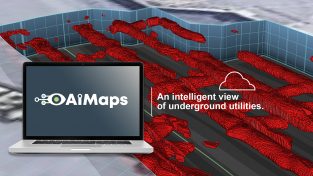In this episode of HxGN Radio, Senior Product Manager at Leica Geosystems Johannes Hotz discusses how the easy-to- use Leica Zeno 20 is giving traditional and non-traditional measurement professionals alike access to valuable GIS, a system previously reserved for a select group. To listen to more HxGN Radio episodes, visit our channels on iTunes, SoundCloud or Stitcher.
Welcome to HxGN Radio. This is your host Veronica Miller, and thank you for joining us for today’s podcast episode titled “Democratising GIS” brought to you by Hexagon Geosystems. In today’s podcast we are talking to Johannes Hotz Senior Product Manager at Leica Geosystems. Thank you Johannes for joining us today. With this year’s release of the Leica Zeno 20, hand held collector asset collection and management has been simplified so even none GIS professionals can easily capture insert and manage all sorts of data. This idea of opening up GIS to all or democratizing GIS is a growing concept in the industry.
VM: Johannes, thank you for coming today. Let’s get started. So what does democratizing GIS mean to you?
JH: Thank you Veronica, and for me for sure you can look from a bigger picture point of view and this about improved location intelligence with many sources of information; however, if I look into what our customers are doing daily in the field it’s to improve their productivity. And what does this mean in detail? Often our field users are, as you mentioned before, not GIS professionals out in the field or are not surveyors; however, they have the task to collect accurate precision data with a lot of source of information. So this could be any descriptive information like for example, if you look at a manhole from a utility site, if it’s buried, if it’s blocked, if it’s clean enough, if the water can flow good enough in case of heavy rains. So all these systems they collect information and they are experts in a certain field like a utility technician is not an expert in GIS or in surveying; however, they have to task, as I said before to collect accurate data. As a consequence, if they are not familiar with GIS, they very often use paper and pen and record the position maybe using a tape and back in the office the data must be redrawn in the map to create accurate information in the GIS. Or they use digital systems, which are very complex to use and they require a lot of training for those field users. This means democratisation of GIS as consequence you can increase the product if you use the field crews if you can offer a solution that is easy and simple to use.
VM: How is it that the Leica Zeno 20 is leading the charge here?
JH: Well, the Zeno 20 and especially the software which runs on the Zeno 20, like the Zeno mobile, a complete new developed software that is based on Android and an Android operating system, or also the collector for ArcGIS from ESRI. It’s simply a tool for everyone. When designing the Zeno 20 and the Zeno mobile we focused on simplifications of this password, which just means making complex things simple. For example, all complexity of, again talking as a surveyor, complex coordinating systems, geo, it’s transformation, transformation models in the background. This is all heightened by the customer and we can even allow him to change the coordinating system once he’s started with a different as he may make a mistake. So all points are reprojected. So really complex things we put in the background and look at the user interface, which is another very important thing to make it clean and easy to use user interface in the foreground simple, not many tools, not many toolbars where things are hidden. Now very clean and simple thing that people can see themselves very easily.
Next thing, is for sure the intuitiveness. Our software runs like Google Maps so you operate it. You have slider from the bottom. You have a slider from the left. You can you use gestures for some in, some out rotation of pan, etc. So a lot of tools which traditionally used in toolbars are now part of the user end experience in the field. And there’s for sure multiple ways to get to information. If you want to change a setting you can find different ways to make it become again a very simple and learning experience. And lastly, what we do is a quite a lot of education. So we have user interface videos explaining the first steps, the first five minutes to use, the user experience, and how to open the box and about how to start. Then we have simple quick guides for the customers to get into the system and to use them there. All this together forms a solution that our customers are not requiring training. So if the customer gets the Zeno 20 the first time, he can simply open the box and he’s ready to start the fice minute kick off video. It’s efficient for him to be productive in the field and this is what attracts today our customers. Again, because they can use it in the field without training and everyone in the field can use it.
VM: So the goal here is to make it at user friendly as possible?
JH: Absolutely.
VM: With that in mind, what would you say to the critics who say this is simply over simplification of the field?
JH: Do you know what happen in 2007? That’s an unfair question I know. [laughing]But Apple released the first iPhone. And who thought prior to this release is that you can do more with a phone, a mobile phone, cell phone, that you can do more than SMS, text messaging and phoning. No one. Apple understood at this point in time to make complex things easy and the consequence of this one, there’s a huge adoption rate of it. Before you use your phone, you make your calls, you use your laptop to make your emails, you use the internet to browse things. Now you have apps, use apps, games. Clear? Makes fun. It’s always about enjoyment but this is the interesting part and again, the same applies to our industry, to get a high acceptance rate, a high adoption rate from the customer base because you can tell very often people you have to use it. If they’re not feeling comfortable then we always find ways to navigate this one around. But it must be simple. It must be easy. It must be intuitive and it must be a joy of use and it must be as simple as paper and pen, and it must have the benefits of instant maps in the field. And the Zeno 20 and simplification and our democratisation of GIS is exactly delivering this one to our customer base.
VM: Going off the Apple example you know over years it really was solidified in the field and became the go to for that type of technology and user friendliness. So how do you think this concept will evolve in the future?
JH: This means it will be many, many more field users use it. If you look at a utility company, they have hundreds of field users and they all together are disconnected very often from the office. They get their work from management or workforce task by an email or by a different kind of…. On a paper in the morning. They collect the data in not one system. What I strongly believe that all together forms comes into one big end solution where this data is entered and managed. For example, if what I see ESRI and us is doing. They have a complete open GIS where there they can have then dedicated field apps. One is the workforce management app. The other is the collector and all this forms together into one backend.
VM: Other than simplifying processes, what other benefits do you see with democratising GIS?
JH: Well it gives a huge flexibility on our customer side. A field crew leader can more flexibly plan the field tasks because he doesn’t need his one specialized to have to do maybe two jobs a day. The simplification allows him to utilize the stuff he has in a very, very simple way and that everyone can do this task because the learning curve is so slow. So I think this is a big flexibility but more importantly it comes to the GIS manager. It’s leveraging the investment he has done into the GIS which is millions very often and very often he elects of this accurate data in the field. And this process and these are the benefits he can increase from in democratisation of GIS. It’s a tool with high accurate data collection for everyone.
VM: How do you think this concept will evolve in the future?
JH: Well it’s getting more information. Classically, for sure you can collect more sensors. And it’s in Europe where I come from very often you have to map the underground assets, electric cables and pipelines and you can use the underground asset data collects sort of like the DigiCAD from Leica Geosystems. But if I look a bit more in the future it’s this internet of things, ideas and concepts which go into this one, to support reliable and accurate data collections with many, many sources of information and it’s not necessarily a PC. It could be a variable. It could be something we just blocked onto a lamp post or things like that.
VM: And speaking of the future. Do you have any future plans for… well not maybe you specifically [laughing]but Leica Geosystems. Do you have any future plans for the Leica Zeno 20 in this dialogue?
JH: Yes, you’re absolutely right. [laughing]I have many future plans for the Zeno 20. The Zeno 20 was now released in June of this year at Hexagon Live in Las Vegas and since then we have received so many positive feedbacks. The Zeno 20 is a big success for Hexagon Geosystems in terms of selling but also what I think is more important about the adoption rate by customers because people love the freshness of the solution. The people love that it’s based on Android. It’s simple to use. That they can really go out and start training if you do demonstrations with a customer. The customer is not getting trained. You have to do get the device and they are ready to go and do the high data collection. So therefore I believe the plans of the Zeno 20 to have an all-in-one device with accurate data, with an open operating system like with Android where you can plug in your apps greatly. What we will look at for sure is to increase the functionality of Zeno Mobile that we support more sensors, as I said before, underground asset collectors, internet of things type of devices but also what we believe is supporting apps. So that our partners can bring their apps onto the Zeno 20 and get more out of it.
VM: So just making it really as integral as possible for your customers to be using it on the field with their phones as seamlessly as possible.
JH: Absolutely. This is the source of information and lead device for field crews which is used in the field and the daily operation. Independent workers and who uses it.
VM: Thank you for stopping by today. We really appreciate your time and thank you for being our guest.
Tune into more episodes from HxGN Radio on ITunes, SoundCloud, or on our Stitcher channel. Thanks for listening.













![[PODCAST]: Democratising GIS](https://blog.hexagon.com/wp-content/uploads/2016/02/artworks-000148309921-plyw2h-t500x500-500x391.jpg)



